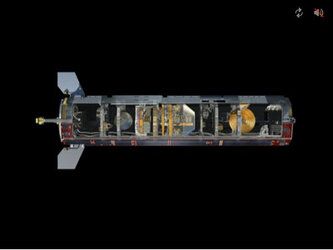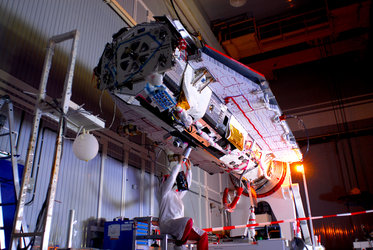Building ESA's gravity mapping mission posed hi-tech challenge
While ESA's Earth Explorers have been conceived as scientific tools to investigate aspects of the Earth system, achieving their goals has required stretching technological limits. With GOCE (Gravity field and steady-state Ocean Circulation Explorer) that is certainly the case: to achieve its gravity-mapping goal the spacecraft has had to be designed and built from scratch, with almost no off-the-shelf parts.
In particular the gravity field measurement sensor at its heart is the product of more than two decades of research, embarked upon through the Agency’s Earth Observation Preparatory Programme (EOPP) and Earth Observation Envelope Programme (EOEP), while the TRP and follow-on General Studies Technology Programme (GSTP) also fostered GOCE’s innovative ion propulsion system – the pair together being crucial for mission success.
All GOCE has to do to operate optimally is remain subject to gravity. On a basic level that is all any satellite does– being in orbit equals a state of perpetual free-fall, getting tugged downward by Earth's gravitational field while flying sideways too fast to hit the ground. But the technological challenge of GOCE is unique: success requires cancelling out all the other forces acting on the spacecraft, so spatial variations in Earth's gravity field can be charted more accurately than ever before.

Each of the three pairs of accelerometers forming GOCE's gravity-detection instrument are a hundred times more sensitive than any previously flown in space, but to maximise their gravity signal the spacecraft still needs to hug its home planet as closely as possible. Gravity follows the inverse square law – double the distance and gravitational attraction decreases fourfold – which makes it is a phenomenon best studied in close-up. So GOCE flies lower than any satellite before it, at a circular altitude of close to
However, atmospheric density also increases exponentially with decreased height – and at GOCE's altitude air friction is enough to drag a satellite out of orbit in a matter of weeks or months. GOCE has to compensate for air drag firstly to stop itself from burning up in the Earth's atmosphere, but also prevent any jitters caused by constantly-shifting atmospheric friction or even the pressure of sunlight.
Overall all non-gravitational forces need to be continuously rejected down to a single part in
Contact
Rune.Floberghagen @ esa.int










